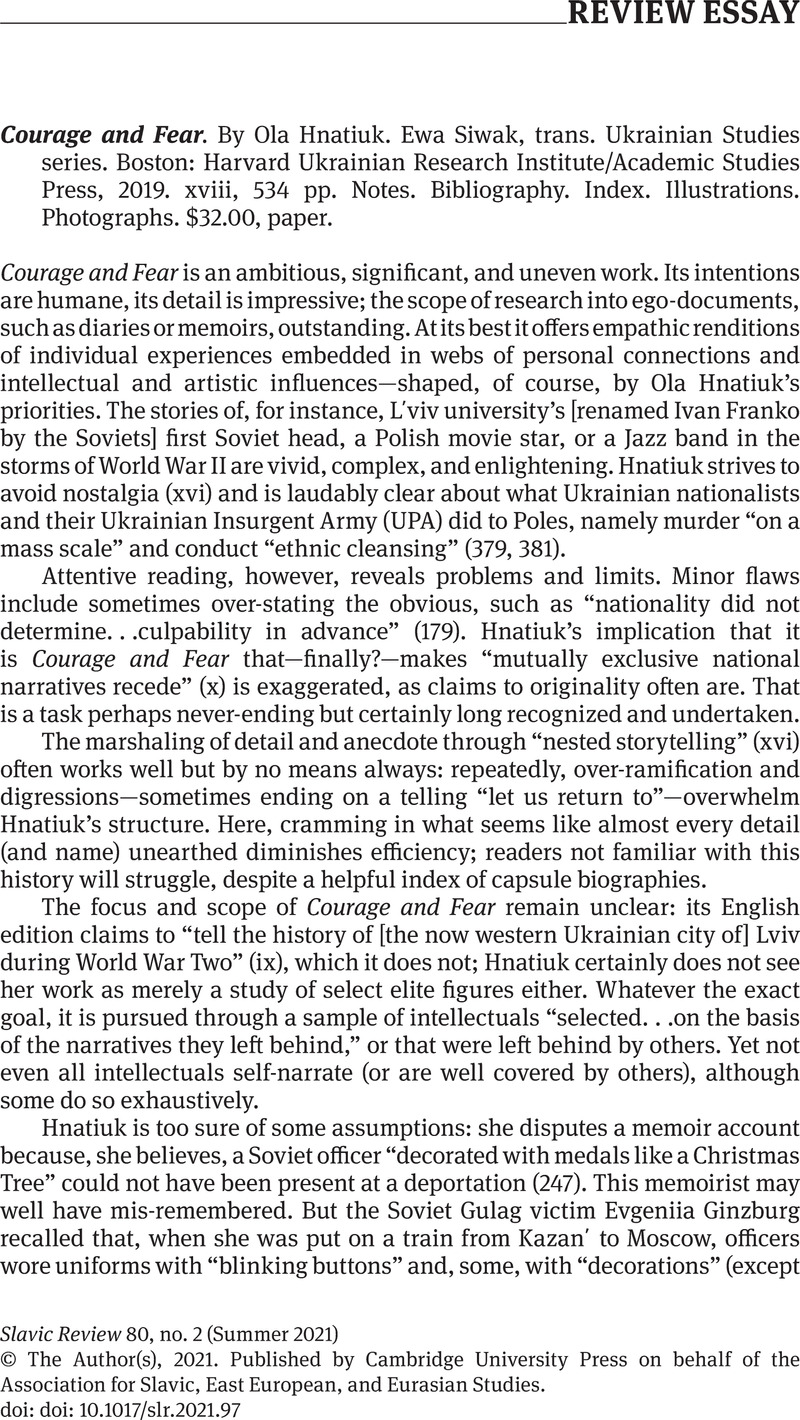No CrossRef data available.
Article contents
Courage and Fear. By Ola Hnatiuk. Ewa Siwak, trans. Ukrainian Studies series. Boston: Harvard Ukrainian Research Institute/Academic Studies Press, 2019. xviii, 534 pp. Notes. Bibliography. Index. Illustrations. Photographs. $32.00, paper.
Review products
Published online by Cambridge University Press: 06 September 2021
Abstract

Information
- Type
- Review Essay
- Information
- Copyright
- Copyright © The Author(s), 2021. Published by Cambridge University Press on behalf of the Association for Slavic, East European, and Eurasian Studies
References
1. Ginzburg, Evgeniia, Krutoi Marshrut (Moscow, 2007), 126Google Scholar.
2. For instance, Rudling, Per Anders, “‘They Defended Ukraine’: The 14. Waffen-Grenadier-Division der SS (Galizische Nr. 1) Revisited,” Journal of Slavic Military Studies, vol. 25, no. 3 (July-September 2012): 338CrossRefGoogle Scholar; Khromeychuk, Olesya, “Ukrainians in the German Armed Forces During the Second World War,” History: The Journal of the Historical Association, vol. 100, no. 5 (343) (December 2015): 720CrossRefGoogle Scholar.
3. Hirsch, Francine, Empire of Nations: Ethnographic Knowledge and the Making of the Soviet Union (Ithaca, 2005)Google Scholar; Slezkine, Yuri, “The USSR as a Communal Apartment, or How a Socialist State Promoted Ethnic Particularism,” Slavic Review, vol. 53, no. 2 (Summer 1994): 414–452CrossRefGoogle Scholar.
4. Rich, David Alan, “Armed Ukrainians in L΄viv: Ukrainian Militia, Ukrainian Police, 1941 to 1942” Canadian-American Slavic Studies, vol. 48, no. 3 (January 2014): 271–87CrossRefGoogle Scholar; Finder, Gabriel N. and Prusin, Alexander V., “Collaboration in Eastern Galicia: The Ukrainian Police and the Holocaust,” East European Jewish Affairs, vol. 34, no. 2 (August 2004): 96CrossRefGoogle Scholar.
5. Khromeychuk, “Ukrainians in the German Armed Forces,” 711–13.
6. Lower, Wendy, “Pogroms, Mob Violence and Genocide in Western Ukraine, Summer 1941: Varied Histories, Explanations and Comparisons,” Journal of Genocide Research, vol. 13, no. 3 (September 2011): 217–46CrossRefGoogle Scholar; Himka, John-Paul, “The Lviv Pogrom of 1941: The Germans, Ukrainian Nationalists, and the Carnival Crowd,” Canadian Slavonic Papers, vol. 53, no. 2-4 (June 2011): 209–43CrossRefGoogle Scholar; Struve, Kai, “The OUN(b), the Germans, and Anti-Jewish Violence in Eastern Galicia during Summer 1941,” Journal of Soviet and Post-Soviet Politics and Society, vol. 6, no. 1 (2020): 205–235Google Scholar [a summary of idem, Deutsche Herrschaft, ukrainischer Nationalismus, antijüdische Gewalt. Der Sommer 1941 in der Westukraine (Berlin, 2015)].

